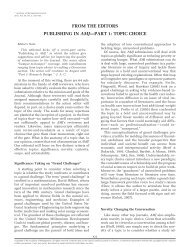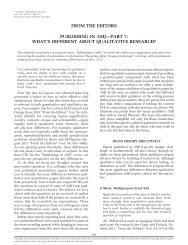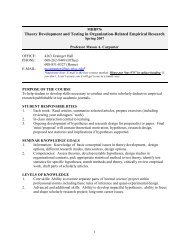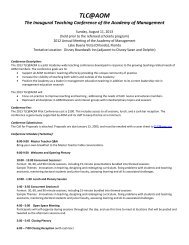inductive reasoning and the creation and justification of new ventures
inductive reasoning and the creation and justification of new ventures
inductive reasoning and the creation and justification of new ventures
Create successful ePaper yourself
Turn your PDF publications into a flip-book with our unique Google optimized e-Paper software.
2010 Cornelissen <strong>and</strong> Clarke<br />
553<br />
applies to <strong>the</strong> context <strong>of</strong> <strong>new</strong> <strong>ventures</strong>—where<br />
<strong>the</strong> dem<strong>and</strong>s <strong>of</strong> online sensemaking require<br />
that individual entrepreneurs think by speaking,<br />
meaning that conscious thought emerges<br />
in <strong>the</strong> act <strong>of</strong> speaking with o<strong>the</strong>rs (Hill & Levenhagen,<br />
1995)—but potentially also extends<br />
to sensemaking in o<strong>the</strong>r social <strong>and</strong> organizational<br />
settings.<br />
Existing research on sensemaking, however,<br />
largely separates individual cognition, or sensemaking,<br />
from symbolic “sensegiving” processes<br />
in social or organizational settings (see Maitlis<br />
& Sonenshein, 2010; Weick et al., 2005). We argue<br />
instead that language <strong>and</strong> thought interpenetrate<br />
in context <strong>and</strong> that meaning develops as a<br />
result <strong>of</strong> interactions with o<strong>the</strong>rs. In <strong>the</strong> classic<br />
case <strong>of</strong> <strong>the</strong> Mann Gulch disaster (Weick, 1993),<br />
for example, when <strong>the</strong> spotters on <strong>the</strong> aircraft<br />
had labeled <strong>the</strong> fire as a “10 o’clock fire,” <strong>the</strong><br />
firefighters on <strong>the</strong> ground committed <strong>the</strong>mselves<br />
to this interpretation <strong>and</strong> believed it to be<br />
a fire that was relatively contained. According<br />
to Weick (1993: 635), <strong>the</strong>y also reinforced <strong>and</strong><br />
“rationalized this image until it was too<br />
late”—an analysis that points to <strong>the</strong> formative<br />
effect <strong>of</strong> language <strong>and</strong> to social validation in<br />
reifying <strong>the</strong> circumstances <strong>the</strong> firefighters faced.<br />
Ano<strong>the</strong>r more recent study <strong>of</strong> <strong>the</strong> hijacking <strong>of</strong><br />
United Airlines flight 93 (Quinn & Worline, 2008:<br />
501) demonstrates how people aboard <strong>the</strong> plane<br />
responded to this “shocking <strong>and</strong> incomprehensible”<br />
event by constructing a sensible narrative<br />
that allowed <strong>the</strong>m to deliberate <strong>the</strong> action <strong>of</strong><br />
collectively counterattacking <strong>the</strong> hijackers. The<br />
narrative evolved while people on <strong>the</strong> plane<br />
were phoning <strong>the</strong>ir close relatives <strong>and</strong> partners<br />
for approval <strong>and</strong> emotional support, which, in<br />
turn, gave <strong>the</strong> passengers <strong>the</strong> confidence to go<br />
ahead with <strong>the</strong>ir courageous counterattack<br />
(Quinn & Worline, 2008).<br />
Although settings <strong>of</strong> crisis <strong>and</strong> change are not<br />
necessarily <strong>the</strong> same as <strong>the</strong> early stages <strong>of</strong> venture<br />
<strong>creation</strong>, <strong>the</strong>re are clear parallels across<br />
<strong>the</strong>se sensemaking scenarios in <strong>the</strong> sense that<br />
individuals, drawing from <strong>the</strong>ir own experience<br />
<strong>and</strong> identity, construct meaning <strong>of</strong> inchoate circumstances,<br />
while speaking with o<strong>the</strong>rs, <strong>and</strong><br />
reinforce, replace, or adapt <strong>the</strong>ir sensemaking<br />
in <strong>the</strong> context <strong>of</strong> voiced or perceived social expectations.<br />
This particular formulation <strong>of</strong>fers <strong>the</strong><br />
potential for a more parsimonious perspective<br />
on sensemaking that, we argue, may benefit<br />
research. Over <strong>the</strong> past fifteen years, sensemaking<br />
has become an increasingly popular umbrella<br />
construct (Hirsch & Levin, 1999) that has<br />
usurped divergent <strong>the</strong>oretical principles<br />
around, for example, cognitive dissonance, <strong>the</strong><br />
autonomic nervous system, behavioral enactment,<br />
social identity, behavioral routines, emotions,<br />
speech acts, <strong>and</strong> escalation <strong>of</strong> commitment<br />
(e.g., Weick, 1995; Weick et al., 2005).<br />
Integration <strong>of</strong> <strong>the</strong>se principles into a single construct<br />
is laudable, but it lacks specificity <strong>and</strong><br />
provides broad, ra<strong>the</strong>r than specific, guidance to<br />
empirical research.<br />
A fourth related <strong>and</strong> final implication concerns<br />
<strong>the</strong> empirical examination <strong>of</strong> speech <strong>and</strong><br />
communication in entrepreneurship research.<br />
The constructs <strong>and</strong> propositions in our model<br />
can be readily connected to techniques for <strong>the</strong><br />
identification <strong>and</strong> analysis <strong>of</strong> analogies <strong>and</strong><br />
metaphors (e.g., Cornelissen, Oswick, Christensen,<br />
& Phillips, 2008; Putnam & Fairhurst,<br />
2001) <strong>and</strong> <strong>the</strong>ir use in <strong>the</strong> context <strong>of</strong> entrepreneurial<br />
sensemaking (e.g., Lounsbury & Glynn,<br />
2001) 1 . For example, fur<strong>the</strong>r research may systematically<br />
study argument constructions (Goldberg,<br />
1995), which provide <strong>the</strong> <strong>inductive</strong> core<br />
around which entrepreneurs elaborate larger<br />
scenarios or narratives for <strong>the</strong>ir <strong>ventures</strong>. Such<br />
studies will buttress <strong>the</strong> arguments <strong>and</strong> analyses<br />
<strong>of</strong> <strong>the</strong> burgeoning tradition <strong>of</strong> interpretive<br />
research on entrepreneurial narratives (e.g.,<br />
Martens et al., 2007).<br />
We fur<strong>the</strong>rmore believe that a key strength <strong>of</strong><br />
our <strong>the</strong>orizing is that it provides a potential<br />
foundation for empirical process studies <strong>of</strong> <strong>the</strong><br />
proposed links between an entrepreneur’s prior<br />
experience <strong>and</strong> speech, social contexts <strong>of</strong> speaking,<br />
<strong>and</strong> institutionalized discourses in an industry,<br />
using ei<strong>the</strong>r a qualitative or quantitative<br />
research design. Each <strong>of</strong> <strong>the</strong> <strong>the</strong>orized links that<br />
we have elaborated <strong>and</strong> illustrated with case<br />
examples (Santos & Eisenhardt, 2009) can provide<br />
<strong>the</strong> focus for intensive qualitative investigations<br />
that might serve to confirm or refute our<br />
arguments, as well as flesh out <strong>the</strong> details <strong>of</strong><br />
<strong>the</strong>se complex relationships. The model could<br />
1 We restrict our focus here to verbal analogies <strong>and</strong> metaphors.<br />
We acknowledge that <strong>inductive</strong> <strong>reasoning</strong> may also<br />
involve analogies or metaphors in o<strong>the</strong>r “modalities,” including<br />
<strong>the</strong> drawing <strong>of</strong> pictorial images or <strong>the</strong> construction<br />
<strong>of</strong> prototypes or artefacts (e.g., Cornelissen et al., 2008), but<br />
this is beyond <strong>the</strong> scope <strong>of</strong> <strong>the</strong> paper. We thank one <strong>of</strong> <strong>the</strong><br />
reviewers for providing this insight.










